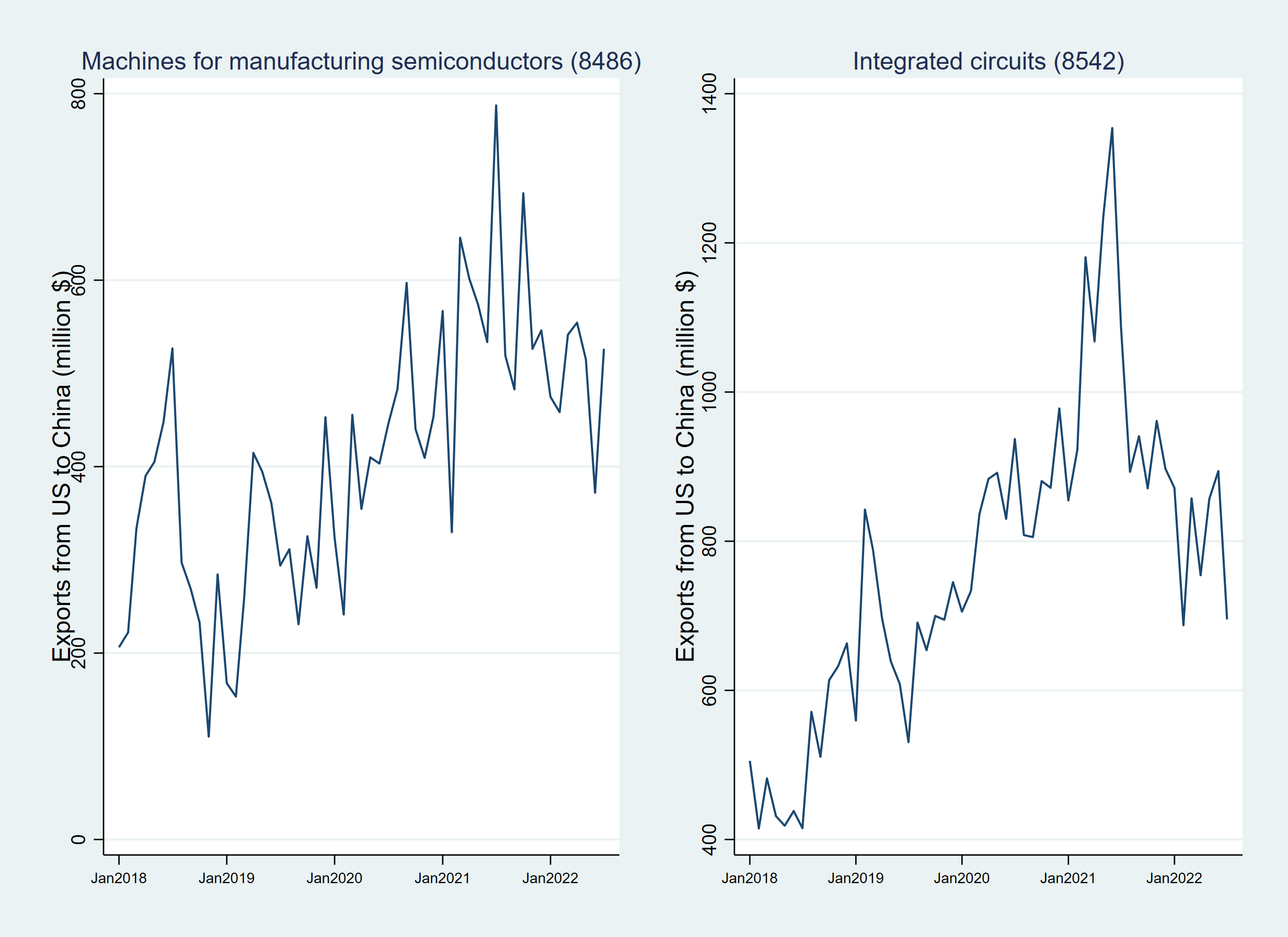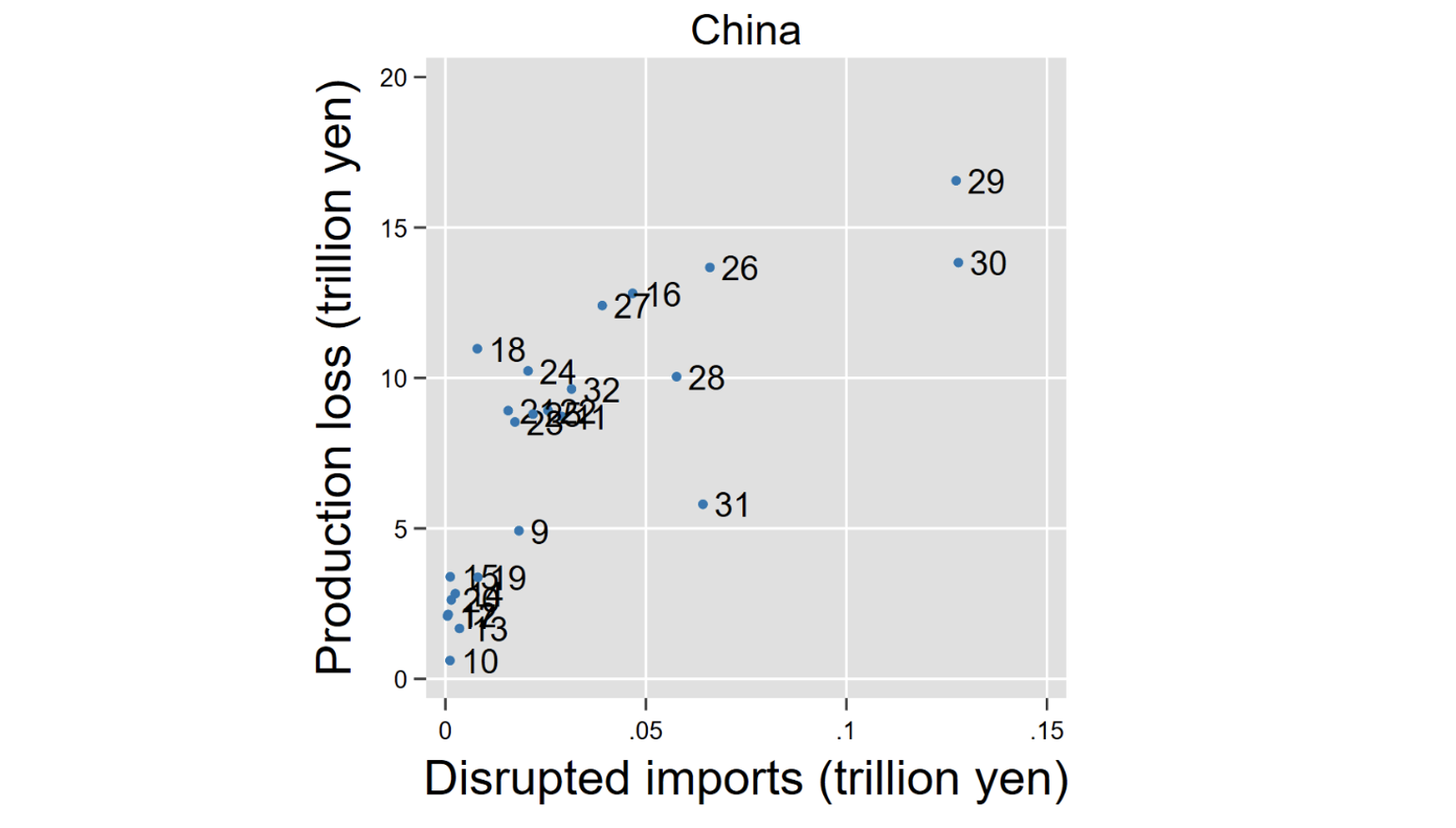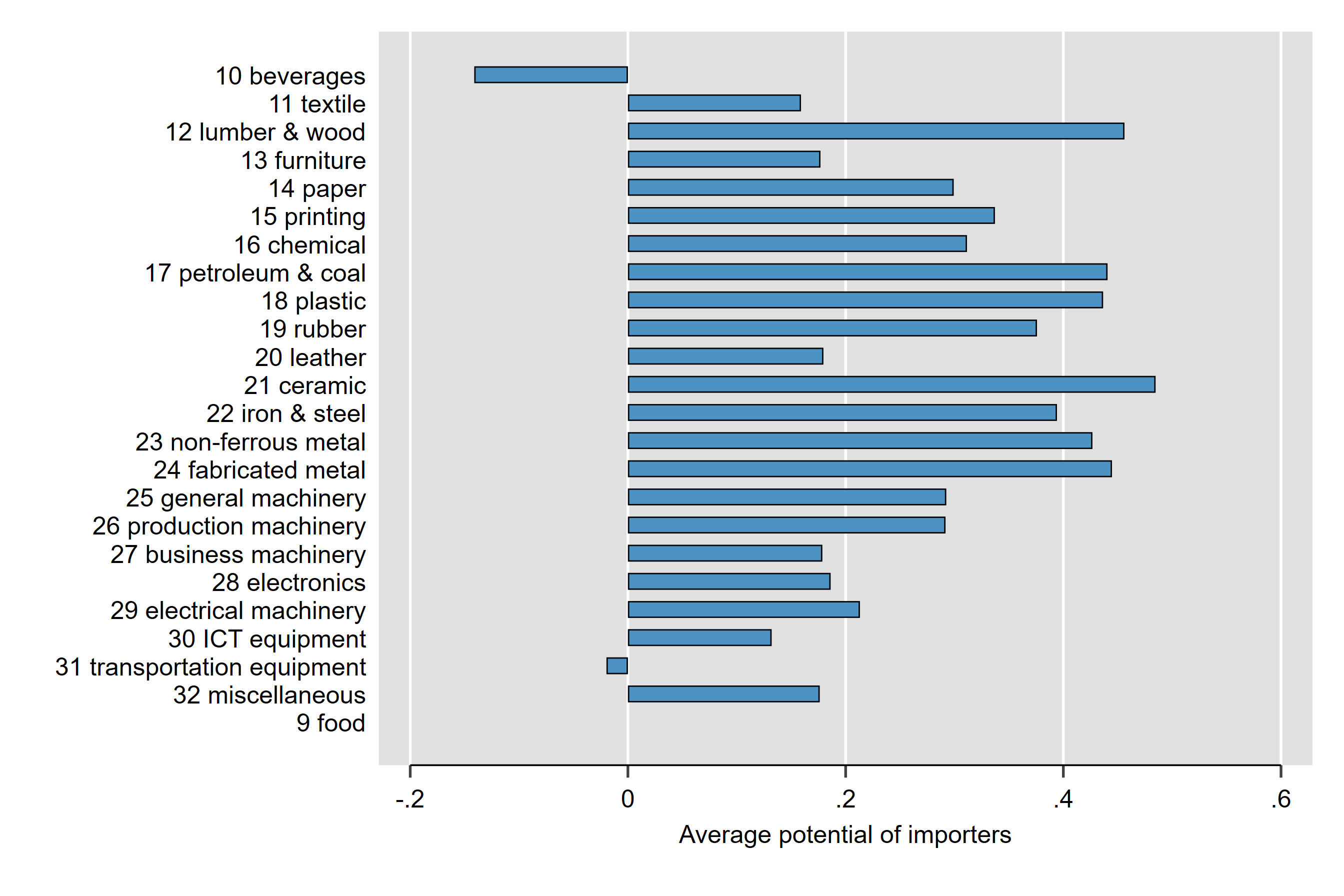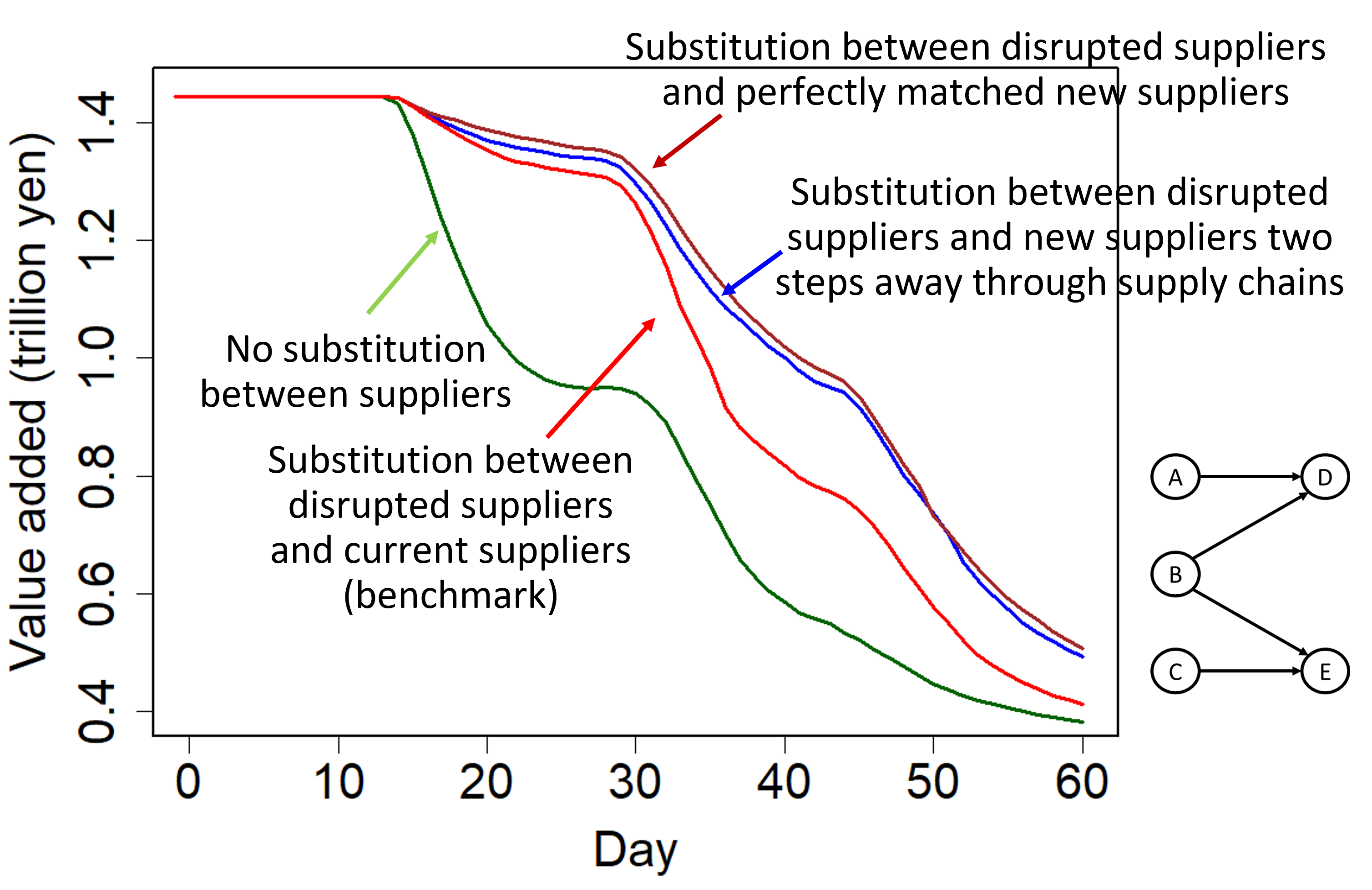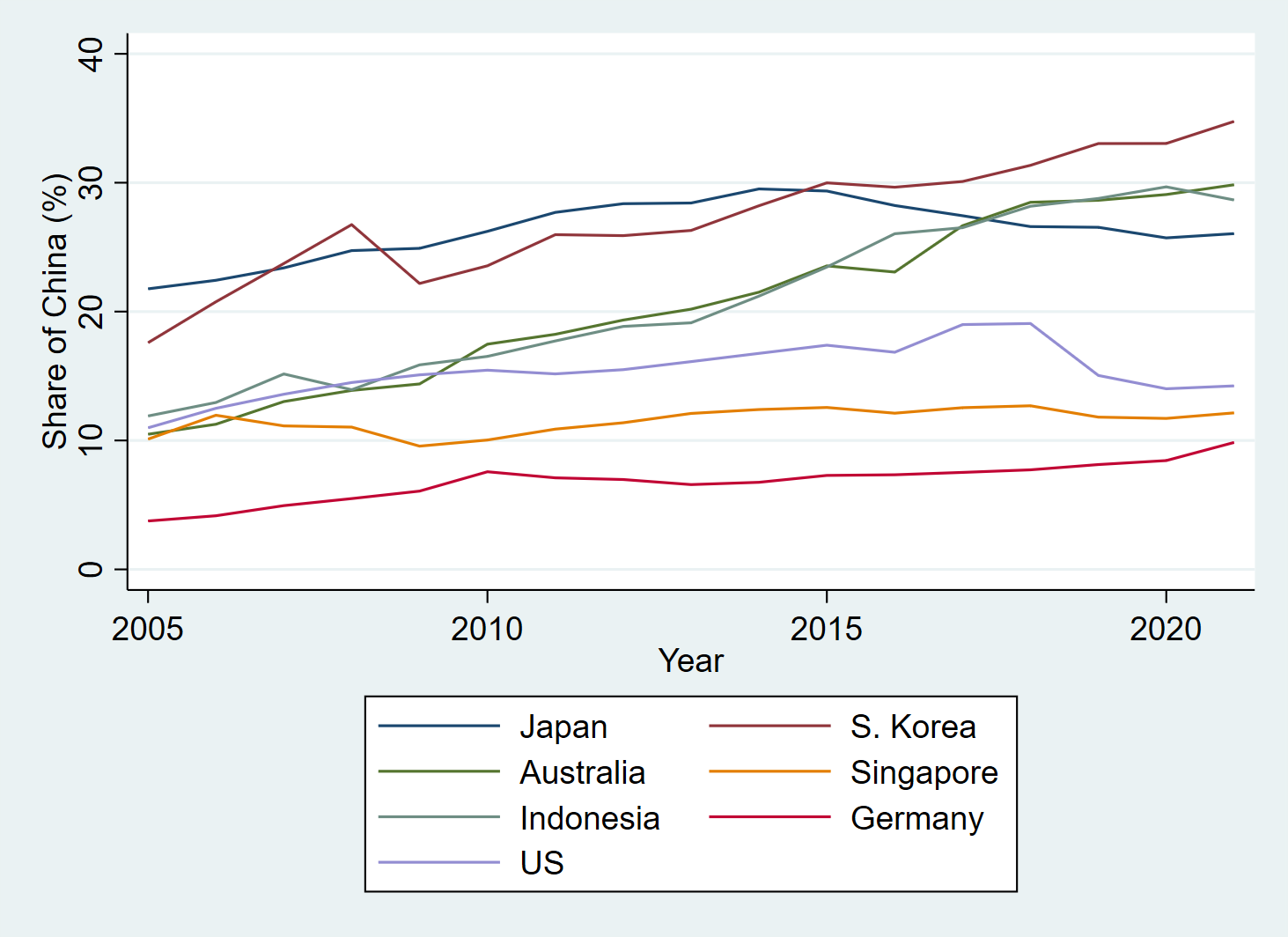In recent years, global supply chains have often been disrupted. For example, because of lockdowns in various cities and countries to prevent the COVID-19 pandemic in 2020, international trade in material, parts, and components shrank substantially, resulting in reduced production in importer countries. Since 2019, the US has restricted exports of goods produced in the US, and goods produced using US-made equipment, to a number of Chinese high-tech firms such as Huawei to reduce national security threats from China. More recently, it has strengthened export controls even further. Exports of semiconductor-related products from the US to China have declined drastically since early 2021 (Figure 1) in response to the controls. Moreover, because of the Russian war in Ukraine and economic sanctions on Russia associated with the war, exports of natural gas, minerals, and cereals and grains from the two countries have declined. This raises concerns that the disruption of global supply chains is being further exacerbated because of national security issues.
Figure 1 Exports of semiconductor-related products from the US to China
Source: UN Comtrade.
According to an emerging strand of literature, the effect of such supply chain disruptions will propagate widely through, and be magnified by, supply chains (Barrot and Sauvagnat 2016, Carvalho et al. 2021). At the beginning of the COVID-19 pandemic, Guan et al. (2020)estimated that a six-month lockdown in China could result in a reduction in world GDP by 12%, by simulating a model that incorporates input-output linkages across countries and sectors. We estimated in earlier work (Inoue and Todo 2020) that a one-month strict lockdown of only Tokyo could reduce Japan’s GDP by 5%.
Although our research (Inoue and Todo 2020) used a simulation approach similar to Guan et al. (2020), one advantage of our method is that we used firm-level data for 1 million firms and 4 million supply chain relationships in Japan, as opposed to Guan et al. (2020) and others whose simulations use industry-level data. Therefore, we could incorporate the complexity of firm-level networks, which enhances the propagation of the economic effect through supply chains. However, one notable shortcoming of our paper (Inoue and Todo 2020) and its predecessor (Inoue and Todo 2019), is that we used domestic supply chains within Japan due to data limitations, and thus could not examine the effects of global supply chain disruptions resulting from trade restrictions and conflicts, for example, on the domestic economy.
Our recent work, Inoue and Todo (2022), overcomes this shortcoming by combining two firm-level datasets for Japanese firms: one for domestic supply chains and the other for international trade. The simulation result shows that when imports of inputs from China are disrupted by 80% for two months, the total production in Japan during the same period declines by 15%. In this scenario, although the value of disrupted imports is only 1.4 trillion yen ($95 billion), the reduction in production (sales) would be 53 trillion yen ($360 billion), almost 40 times as large as the initial shock. This prediction indicates that the effect of the disruption of global supply chains on the domestic economy is substantially magnified as the effect propagates through domestic supply chains.
We also find that the level of magnification is largely affected by the structure of domestic supply chains. For example, although the disruption of intermediate imports from China is approximately half the value of those from other Asian countries, the production loss is almost the same in the two cases (the left panel of Figure 2). In other words, the correlation between the disruption in imports and the reduction in production is not that strong. By contrast, the reduction in production is more clearly correlated with the number of importers and number of their clients (the middle and right panels), highlighting the importance of the structure of supply chains to the magnification.
Figure 2 Determinants of production loss in Japan because of disruption of imports by region
Source: Inoue and Todo (2022)
Notes: Each dot indicates the relationship between characteristics of imports and the predicted decrease in production, assuming a 80% disruption of imports from each region lasting two months.
We further simulate the effect of disruption of imports from each region by industry. Figure 3 particularly shows the results from the case of an import disruption from China. One notable finding in this figure is that while the disrupted imports and resulting production loss are positively correlated, the production loss for industry 31 (the transportation equipment industry), is relatively small compared with the value of disrupted imports. The value of disrupted imports of the transportation equipment industry is similar to that of the production machinery (26) and electronics (28) industries, but the production loss is substantially larger in the case of the latter two industries.
Figure 3 Relation between the production loss in Japan and disrupted imports from China by industry
Source: Inoue and Todo (2022)
Notes: Each dot indicates the relationship between disrupted imports and the predicted decrease in production, simulating a 80% disruption of imports from China to a particular manufacturing industry lasting two months. See Figure 4 for industry classifications.
To examine the causes of the observations, we look at the role of the ‘upstreamness’ of importers in each industry. To measure the upstreamness at the firm level, rather than at the industry level as usually measured in the literature (Antràs and Chor 2013), we employ the Helmholtz-Hodge decomposition (Jiang et al. 2011) that can decompose a supply-chain link into hierarchical (upstream to downstream) and circular flows to compute the ‘potential’ of each firm, which is a measure of upstreamness in domestic supply chains. The average of the potential among importers of Chinese products by industry is provided in Figure 4.
Figure 4 clearly shows that importers in the transportation equipment industry are more downstream in domestic supply chains. In other words, in the transportation equipment industry, Japanese firms import semi-final products and assemble them domestically. Therefore, the effect of disruption of imports only propagates through short domestic supply chains and is not magnified substantially. By contrast, in the production machinery (26), electronics (28), electrical machinery (29), and ICT equipment (30) industries for which disrupted imports are as large as or larger than those for the transportation equipment industry (Figure 3), importers are further upstream. Therefore, the effect of disruption of imports in these industries propagates to a number of downstream clients directly or indirectly connected to importers through long supply chains, leading to large production losses.
Figure 4 Average measure of ‘upstreamness’ of importers by industry
Source: Authors’ calculation
Note: These numbers are averages of firms importing inputs from China. The numbers should be evaluated on a relative basis, and not in absolute terms.
Finally, we find that substitution between suppliers can largely alleviate the propagation of the effect of import disruption, as found in the literature (Barrot and Sauvagnat 2016). Using various assumptions about possible substitution between suppliers, Figure 5 illustrates changes over time in value added production from an 80% disruption of imports from overseas lasting two months. The red line shows results assuming that suppliers whose input supplies were disrupted can be replaced with only currently connected domestic suppliers in the same industry, and not new suppliers. The brown line shows results assuming that disrupted input supplies can be procured from a new supplier chosen from the full set of suppliers in the same industry (as long as its production capacity allows). The production reduction shown by the brown line is smaller than that of the red line, indicating that substitution between suppliers can alleviate the negative effect of import disruption.
More importantly, we find that restricted substitution between suppliers, i.e. substitution of inputs only from neighbouring suppliers within supply chains for disrupted inputs, can have a large impact. The blue line indicates the results assuming that disrupted inputs can be procured from new suppliers within two steps of supply chains in the same industry. For example, if supplies from firm B to firm D are disrupted in the right panel of Figure 5, D may procure inputs from C (assuming that B and C are in the same industry). The difference between the blue and brown lines is negligible in Figure 5, suggesting that restricted substitution between supply-chain neighbours can work as well as perfect substitution, which is impossible in practice.
Figure 5 Reduction in value-added production because of import disruption using various assumptions about substitution between suppliers
Source: Inoue and Todo (2022)
Note: In all scenarios, we assume that imports from the world reduce by 80% for 60 days.
Our findings provide important policy and managerial implications. First, the effect of import disruption on domestic production is magnified by domestic supply chains and thus would be quite substantial compared with the amount of disrupted imports. Second, the level of magnification of the effect of import disruption depends on the supply chain structure, for example, the number of importers and their upstreamness in domestic supply chains. In particular, the effect of disruption of imports of ICT-related products from China would be quite large because of their upstreamness. As the risk of large-scale disruption of international trade resulting from national security issues becomes larger, policymakers and private firms should be aware of this substantial impact.
As our results emphasise the importance of input substitution, one way to reduce the negative impact is to set up a business continuity plan and to pre-arrange possible substitution between suppliers in case of supply chain disruptions. A frontrunner in this strategy is Toyota Motors, which experienced large-scale disruptions after the Great East Japan earthquake in 2011 and thus has created a detailed database of its direct and indirect suppliers, which it calls “RESCUE,” so that it can quickly find a substitute supplier when any supply is disrupted (McDaniel 2022). Furthermore, if we interpret our result in terms of the importance of supplier substitution more broadly, another strategy would be to reduce heavy reliance on a particular country in global supply chains and to diversify partner countries. In fact, the US has recently drastically reduced its reliance on China in terms of imports of parts and components, while other countries have increased theirs (Figure 6). Japan has also reduced its reliance since 2015, but there may be room for further reduction, because China’s share of imports to Japan is still high compared with others, such as the US and Singapore. Firms and governments should effectively utilise these and other measures to prepare for potential disruptions of global supply chains.
Figure 6 Share of China in intermediate imports
Source: UN Comtrade.
Editor’s note: The main research on which this column is based (Inoue and Todo 2022) first appeared as a Discussion Paper of the Research Institute of Economy, Trade and Industry (RIETI) of Japan.
References
Antràs, P and D Chor (2013), “Organizing the Global Value Chain”, Econometrica 81(6): 2127-204.
Barrot, J-N and J Sauvagnat (2016), “Input Specificity and the Propagation of Idiosyncratic Shocks in Production Networks”, The Quarterly Journal of Economics 131(3): 1543-92.
Carvalho, V M, M Nirei, Y U Saito and A Tahbaz-Salehi (2021), “Supply Chain Disruptions: Evidence from the Great East Japan Earthquake”, Quarterly Journal of Economics 136(2): 1255-321.
Guan, D, D Wang, S Hallegatte, S J Davis, J Huo, S Li, Y Bai, T Lei, Q Xue and D’M Coffman (2020), “Global Supply-Chain Effects of Covid-19 Control Measures”, Nature Human Behaviour 4: 577-87.
Inoue, H and Y Todo (2019), “Firm-Level Propagation of Shocks through Supply-Chain Networks”, Nature Sustainability 2: 841-47.
Inoue, H and Y Todo (2020), “The Propagation of the Economic Impact through Supply Chains: The Case of a Mega-City Lockdown against the Spread of Covid-19”, PLOS One 15(9): e0239251.
Inoue, H and Y Todo (2022), “Propagation of Overseas Economic Shocks through Global Supply Chains: Firm-Level Evidence”, RIETI Discussion Paper, Research Institute for Economy, Trade and Industry.
Jiang, X, L-H Lim, Y Yao and Y Ye (2011), “Statistical Ranking and Combinatorial Hodge Theory”, Mathematical Programming 127 (1):203-44.
McDaniel, C (2022), “Streamlining Toyota’s Supply Chain”, Discourse.

